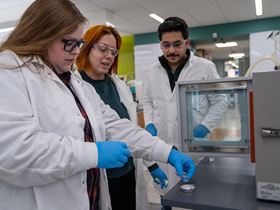Hairy cellulose nanocrystals like to keep their distance


Cellulose nanocrystals – bio-based nanomaterials derived from natural resources such as plant cellulose – are valuable for their use in water treatment, packaging, tissue engineering, electronics, antibacterial coatings and much more. Though they provide a sustainable alternative to non-bio-based materials, transporting cellulose nanocrystals in liquid can prove difficult, due to their propensity for clumping together.
A team of chemical engineering researchers at Penn State have now developed nanotechnology to render cellulose nanocrystals highly redispersible in aqueous mediums, while retaining their full functionality, making them easier to store and transport. They report this work in a paper in Biomacromolecules.
The nanotechnology involves covering the nanocrystals in negatively charged cellulose chains known as hairs. When hydrated, the hairs repel each other via electrosteric repulsion, dispersing the nanocrystals throughout the liquid and preventing them from clumping together.
“We looked at how we could take hairy nanocrystals, dry them in ovens and redisperse them in solutions containing different ions,” explained Breanna Huntington, currently a chemical engineering doctoral student at the University of Delaware and a former undergraduate student at Penn State, who is co-first author of the paper. “We then compared their functionality to conventional, non-hairy cellulose nanocrystals.”
“The hairy ends of the nanocrystals are nanoengineered to be negatively charged and repel each other when placed in an aqueous medium,” added corresponding author Amir Sheikhi, an assistant professor of chemical engineering and of biomedical engineering at Penn State. “To have maximum function, the nanocrystals must be separate, individual particles, not chained together as they are when they are dry.”
After the hairy nanocrystals were dried and then redispersed, the researchers tested them and measured their size and surface properties, and found that their characteristics and performance were the same as those that had never been dried. They also found that the nanocrystals could perform well and maintain their stability in liquids with different salinities and pH levels.
“The hairy nanocrystals can become redispersed even at high salt concentrations, which is convenient, as they remain functional in harsh media and may be used in a broad range of applications,” said co-first author Mica Pitcher, a doctoral student in chemistry at Penn State. “This work may pave the way for sustainable and large-scale processing of nanocelluloses without using additive or energy-intensive methods.”
This story is adapted from material from Penn State, with editorial changes made by Materials Today. The views expressed in this article do not necessarily represent those of Elsevier. Link to original source.



